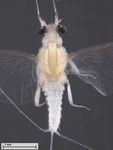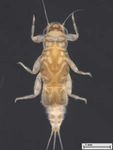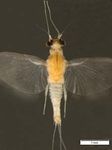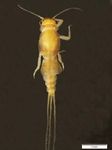WATER AND THE ENVIRONMENT - Feature
←
→
Page content transcription
If your browser does not render page correctly, please read the page content below
Feature
WATER AND THE ENVIRONMENT
New mayfly species discovered in Kruger adding bricks to
conservation foundation
Discovery of new mayfly species in the rivers of the Kruger National Parks illustrates how much
South Africans still need to learn about their freshwater ecosystems. Article by Petro Kotzé.
All photographs supplied
Project leader, Dr Lizaan de Necker, with fellow postdoctoral fellow Dr Hannes Erasmus and Honours students Nobukhosi Sithole and Herman le Roux
conducting field work for the bilharzia research project.
“Mayfly taxonomy is not considered to be a sexy science,” exceptional finds, they are also an important part of a very large
Dr Helen Barber-James says. Though not the most popular picture. Key to unlocking the messages from the mayflies, is
choice of study field, it is very important. Barber-James would calling each by their name.
know. A freshwater biologist, she has dedicated much of
her career to exactly that – the biodiversity, systematics and An important aquatic inhabitant
biogeography of freshwater invertebrates, especially the
Ephemeroptera (mayflies). The name mayfly refers to the time of year they emerge in the
Northern Hemisphere (in spring, typically starting in the month
Nevertheless, there is still much work to be done. Last year, of May). The tiny critters are perhaps commonly best known for
Barber-James led a team that identified two new mayfly species, the short lifespan of the adults (in many cases not even a day,
and at least seven caddisfly species from the Kruger National sometimes only a few hours) and for occasionally emerging in
Park’s rivers. “It’s amazing that we are still finding all these new large swarms depending on the species, but there is much more
species in such well-studied rivers,” she says. The specimens are to them.
tiny; the mayflies only 3 to 4 mm long but, in addition to being
22 The Water Wheel January/February 2021Water and the environment
Mayflies are one of the oldest groups of insects, and date back to Counting critters in the water
the late Carboniferous or early Permian periods, some 290 million
years ago, says Barber-James, who co-published the findings The researchers conducted detailed surveys of the freshwater
on the two mayflies with international mayfly expert, Dr Peter macro-invertebrate fauna of selected rivers within the park.
Malzacher. With funding from the National Research Foundation (FBIP
programme), Rhodes University and the South African Institute
They spend the bulk of their lifetimes unseen under water, of Aquatic Biodiversity (SAIAB), Barber-James led the project in
where, in their developing nymphal stage, they cling to rocks her capacity as head of the Department Freshwater Invertebrates
and aquatic plants, feeding on microscopic plants and bacterial at the Albany Museum, with the help of post-doctoral fellow,
growth (periphyton). A few of them burrow in river banks under Dr Alexandra Holland and several post-graduate students.
the water surface and in the sediments. They play an important
role in nutrient cycling through the aquatic ecosystem and are a It is common practice to record the presence of families of
rich source of food to many other species. freshwater macro-invertebrates when scoring the health of
aquatic ecosystems but, uniquely, this study dug down to
All of these functions make them essential to the ecosystem, but species level. Only looking at family level is far too shallow for a
they are also very sensitive to changes within it. As such, mayflies biodiversity study, Barber-James says.
are indicators of ecosystem health. Several mayfly families are
included as indicators in the South African Scoring System So, with the Kruger rivers survey project, they look at species
(SASS5) biomonitoring system, which forms the backbone of within families of aquatic macro-invertebrates. Documented
South Africa’s River Health Programme. species richness and distribution is then compared to a similar
study carried out in the 1980s (by Moore and Chutter, see
Different mayflies have different sensitivities, so their presence or reference below), to see how the species complement and
absence can tell a lot about the quality of a freshwater system. abundance has changed.
“Every single one of them has a slightly different ecological role
to play, is adapted to live in a particular area, and has a different However, for the species to be documented, they have to be
sensitivity to change,” Barber-James says. Researchers count on known. “We have to know whether it’s a Caenidae mayfly or a
them to indicate the state of the rivers, and in this case, the rivers Baetidae mayfly and within those families what the species are,”
of the Kruger National Park. she says. “Species identification is the foundation of all ecological
studies.”
KNP game guard, Moffat Mambane, with Lyndall Pereira da Conceicoa
and Helen Barber-James. Helen Barber-James finding the best site for sampling.
The Water Wheel January/February 2021 23Water and the environment
Walking to a site with some of the KNP colleagues and game guards.
What’s in a name? However, the classification of the specimens is difficult and
time-consuming. Often there’s not enough literature or
All living things are named according to a classification reference papers published as far back as the 1930s or earlier,
system that dates back a long time ago, developed by a sometimes written in foreign languages, need to be referenced.
Swedish botanist from the 17th century, Linnaeus. With some “It’s a tremendous task,” says SANParks aquatic ecologist, Robin
modifications, this system is still in use today. There are now Petersen, which is why SANParks needs the help of outside
eight taxonomic ranks, which broadly group similar organisms, researchers to do it.
starting with the broadest categorisation and going down to the
finest (species) level. The levels are domain, kingdom, phylum, Unfortunately, the pool of researchers to fish from, is small. This
class, order, family, genus and species. is work for specialists, Petersen says, of which there are only a
small handful with limited networks to call on. Plus, the pool is
To put this in context, the two newly discovered mayflies not growing substantially. “It’s totally not seen as trendy,” Barber-
from Kruger are from the kingdom Animalia, in the phylum James says.
Arthropoda (joint-legged animals), in the insect class and part of
the order Ephemeroptera, meaning they are winged creatures A further challenge is ongoing funding for foundational
with a short life (ephemeral wings). More specifically, they biodiversity research. We are very grateful to the NRF
belong to the family Caenidae, and are part of the genus Caenis, Foundational Biodiversity Information Funding (FBIP)
which is widely distributed in Africa (yet still poorly studied). programme for supporting this project for three years, she
The adult Caenis males are characterised by forceps with a tuft says. The study happened to coincide with a period of extreme
of long spines, while the nymphs typically have square gills drought and, ideally, should have continued into the period of
covering the rest of the gills on the body (hence the common renewed rainfall after the drought broke. But since their funding
name square-gill mayfly). The two new species have been came to an end, they have had to move on to other projects.
named Caenis albicans (referring to the white body) and Caenis
letabanensis (from the Letaba River). This challenge is not new. A 2001 Technical Report (Herbert et
al. 2001) written to bring critical issues relating to taxonomy and
For the sake of comparison, lions and leopards are also part of systematics research in South Africa to the attention of the then-
the Animalia Kingdom, the phylum Chordata, class Mammalia, Department of Arts, Culture, Science and Technology (DACST)
order Carnivora, the family Felidae and the genus Panthera. It’s and the NRF, highlighted that much of South Africa’s unique and
only at species level that they are classified as lion and leopard. diverse biological heritage remains undocumented, and until it is
In the aquatic world, Caenis albicans and Caenis letabanensis are made known and studied, cannot be conserved or utilised.
thus as different and significant as lions and leopards.
The authors warned that capacity for taxonomy and systematics
24 The Water Wheel January/February 2021Water and the environment
Caenis albicans larva Caenis albicans male Caenis breviceps larva Caenis breviceps male
research in South Africa was already in danger of falling below and other upstream land-use activities affecting some of the
critical mass levels, if it had not already done so. The lack of rivers, or coinciding with drought periods. Another serious
systematics research has management implications, up to concern is the presence of the alien freshwater snail, Tarebia
national governmental level and impacts on our country’s granifera. This native to Southeast Asia is outcompeting some
international commitments. of the indigenous aquatic macroinvertebrate fauna and could
be part of the cause of decline in diversity of the indigenous
In Kruger, for example, the project results can advise freshwater macroinvertebrate species.
management strategies. According to the project proposal,
“monitoring of the environmental conditions affecting the There is still much more work to be done in these rivers, Petersen
invertebrate species living in these rivers, and looking beyond says, with different aquatic species in the park that have been
the broad family level used in regular biomonitoring, will allow studied more than others. Fish and riverine areas in general are
recommendations to be made for reducing the pollution levels well defined, and comprehensive inventories on reptilians and
from external land use”. frogs were conducted in the seventies and eighties though few
resurveys have been conducted since.
Furthermore, if rare species are found these can be placed on
the IUCN Red List of Threatened Species, which can help put “There’s endless work,” Barber-James says, “but it’s hampered
pressure on organisations responsible for causing pollution. The by inadequate expertise to really assess the biodiversity of our
benefits of creating a suitable freshwater environment to aquatic systems.” Considering the global realisation of massive decline
fauna will also spillover to other megafauna. in species diversity and numbers over recent years, this work is
timely. What we really need is more people to do this kind of
Already, the aquatic vertebrate species are telling researchers work. Across the continent, she says, we run the risk of losing
much about the state of the Kruger rivers. species quicker than we can record them. Without an efficient
baseline of species in place, we cannot measure change
What the mayflies say effectively. Without this foundation in place, she says, any
knowledge is built on shaky ground. We might never know the
So far, they have sorted, identified and catalogued the samples price that we pay for this gap.
collected over the three-year period and identified some of the
groups to species level, Barber-James says. They focused on
Ephemeroptera, Trichoptera and Plecoptera (the so-called EPT References
indicator species) and Odonata (dragonflies and damselflies).
There are two reasons for this, she says. This first is that these Herbert, D.G., Smith, G.F., Hamer, M.L. and Scholtz, C. 2001.
groups are well recognised as ecologically sensitive. The second Taxonomy and systematics research in South Africa: vital
is the expertise available. For some of the other groups, they research facing a crisis in capacity and resources. Technical
need additional experts for accurate species-level identification. Report. 16 pp.
While the paper on Caenis albicans and Caenis letabanensis Malzacher, P. and Barber-James, H.M. 2020. Two new Caenis
was published earlier this year, Dr Alexandra Holland (under species (Insecta: Ephemeroptera: Caenidae) from the Kruger
National Park, South Africa. African Entomology 28(1): 62–77.
the guidance of (retired) caddis expert at the Albany Museum,
Published 26 May 2020. ISSN 1021-3589 [Print]; 2224-8854
Dr Ferdy de Moor) is still at work on the mentioned caddisfly
[Online] (2020) DOI: https://doi.org/10.4001/003.028.0062
species, as part of her post-doc research.
Moore C.A. and Chutter F.M. 1988. A survey of the conservation
Regardless of the exciting new findings, early results from the
status and benthic biota of the major rivers of the Kruger
surveys also indicated a decline in total mayfly abundance National Park. Contract Report. National Institute of Water
and species diversity over time at some sites. The researchers Research. 55 pp.
concluded that this is possibly due to increased effects of mining
The Water Wheel January/February 2021 25You can also read

























































